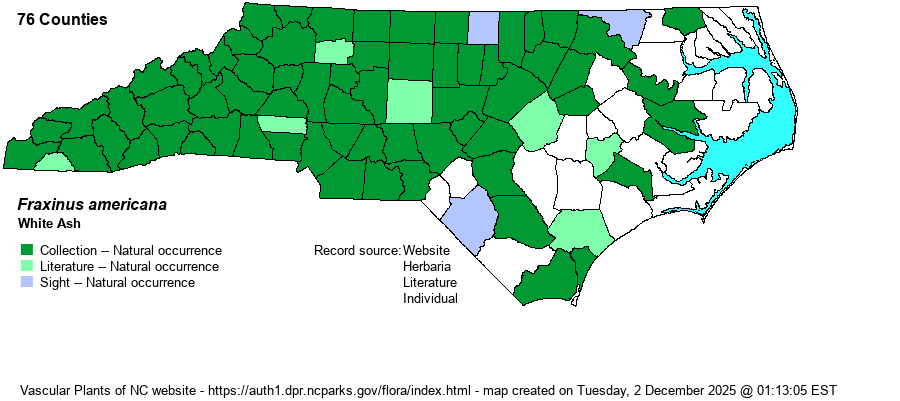| Author | L. | |
| Distribution | Throughout the Mountains, Piedmont, and the western Coastal Plain; absent from the Sandhills proper. Scattered in the central Coastal Plain; scarce to absent over much of the eastern half of the Coastal Plain. Unlike what reference books may say or may show on maps, the species does not occur statewide.
This is a widespread Eastern species, ranging from eastern Canada south to central FL and eastern TX.
| |
| Abundance | Common in the Mountains and Piedmont. Common along the western edge of the Coastal Plain, except absent in the Sandhills proper; uncommon in the central Coastal Plain, and rare to absent in the eastern portions. As the emerald ash borer is advancing southward into northern NC as of 2018, there has undoubtedly been a loss of some to many trees in the northern mountains and northern Piedmont, though the impact has been mainly to Green Ash (F. pennsylvanica). However, in 2022, NatureServe moved the Global Rank up from G5 to now G4; the NCNHP moved the State Rank from S5 to now S4S5 and added the species to its Watch List as W5 (strongly declining). | |
| Habitat | This is a species of mesic to rich soil, of a variety of hardwood or mixed forest types. It grows mainly in uplands, such as in Basic Mesic Forest, Mesic Mixed Hardwood Forest, Rich Cove Forest, various oak-hickory forests, and also on drier soils of wooded glades, at least where the soil is circumneutral. It is generally scarce in wetland forests, and also is absent or scarce in overly acidic soils; thus, most of the Coastal Plain is too acidic or too wet for this species. |
| Phenology | Flowers in April and May, and fruits from August to October. | |
| Identification | This is a familiar, medium to at times large deciduous tree, growing mainly to 75-80 feet tall, rarely over 100 feet tall. All ashes have opposite and compound leaves, with this species having typically seven to nine leaflets, which are entire, elliptical to somewhat lanceolate, and average 4 inches long. The undersides of the leaves are noticeably paler, often glaucous greenish-white, than the medium green upperside. The quite similar Green Ash has leaf undersides relatively medium to light green, but not glaucous colored; it grows only in bottomlands and swamps, but the two could occur together in some higher or drier bottomlands. | |
| Taxonomic Comments | Most references give several varieties for this species. Most list var. biltmoreana, in addition to the typical var. americana, as does NatureServe and RAB (1968). However, Weakley (2018) has var. biltmoreana split out as a good species. In addition, a few references, including Weakley (2018), have split out another species – Small’s Ash (F. smallii); this may be a bit premature at the present time, as so little is known about it.
| |
| Other Common Name(s) | American Ash
| |
| State Rank | S4S5 | |
| Global Rank | G4 | |
| State Status | W5 | |
| US Status | | |
| USACE-agcp | FACU link |
| USACE-emp | FACU link |

